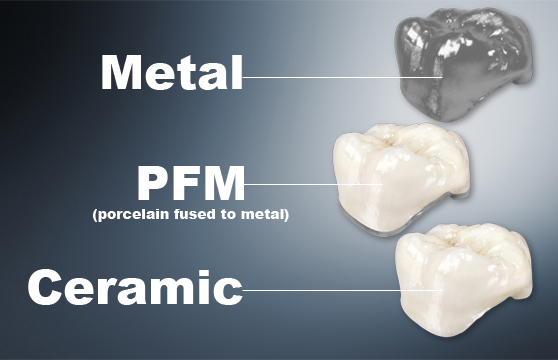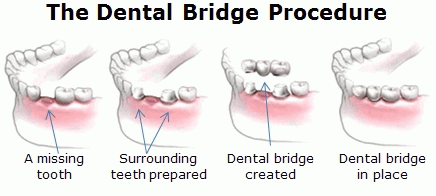Bridges and Crowns
What is a Crown?
If your tooth is damaged but not lost, a crown can be used to restore its shape, appearance and function. You may need a crown if you have a root canal, a large filling in a tooth or a broken tooth. A crown, also called a cap, is a hollow, artificial tooth used to cover a damaged or decayed tooth. The crown restores the tooth and protects it from further damage. Crowns can also be
used to cover a discolored or misshapen tooth. A tooth that has been fixed with a crown works very much like a natural tooth. There are different types of crowns, from porcelain to metal and porcelain mixed with metal inside the crown.
Different types of crowns have different advantages and disadvantages.
Metal crowns can be expensive (if fully gold) or cheaper (if it is a semiprecious metal). Most people choose metal because of insurance coverage, although some choose gold crowns for their molars because it is a stronger option and it never corrodes.
PFM crowns are a more esthetically pleasing option. They have a metal core (Precious or Semiprecious) and a ceramic outer shell. They are the perfect choice for molars because they still possess the strength required for constant chewing and grinding. Unlike the metal crown however, there is a couple of drawbacks to consider. First, the insurance companies will not always cover the cost of the PFM (they will still cover up to the cost of metal crown and the patient would have to pay the difference plus their co-payment) and second, the ceramic on the crown is actually harder than your tooth. Eventually there will be wear marks and restoration will be needed on the opposing tooth/teeth.
Ceramic crowns are the most esthetic option and are usually recommended for the front teeth since they are not used to chew with. The ceramic crowns can be best matched to natural tooth color. There is however a drawback in the fact that it will never change shades. If you wish to have a crown placed on your front tooth, the recommendation is to have whitening done (if your teeth have yellowed or have staining) then wait for 6 weeks before proceeding with your crown appointment.
What is a Bridge?

A bridge is a fixed dental prosthesis used to replace a missing tooth (or several teeth) by joining an artificial tooth permanently to adjacent teeth or dental implants.
A bridge is fabricated by reducing the teeth on either side of the missing tooth or teeth by a preparation pattern determined by the location of the teeth and by the material from which the
bridge is fabricated. In other words, the abutment teeth are reduced in size to accommodate the material to be used to restore the size and shape of the original teeth in a correct alignment and contact with the opposing teeth. The dimensions of the bridge are defined by Ante's Law: "The root surface area of the abutment teeth has to equal or surpass that of the teeth being replaced with pontics".
The materials used for the bridges include gold, porcelain fused to metal, or in the correct situation porcelain alone. The amount and type of reduction done to the abutment teeth varies slightly with the different materials used. The recipient of such a bridge must be careful to clean well under this prosthesis.
When restoring an edentulous space with a fixed partial denture that will crown the teeth adjacent to the space and bridge the gap with a pontic, or "dummy tooth", the restoration is referred to as a bridge. Besides all of the preceding information that concerns single-unit crowns, bridges possess a few additional considerations when it comes to case selection and treatment planning, tooth preparation and restoration fabrication.
